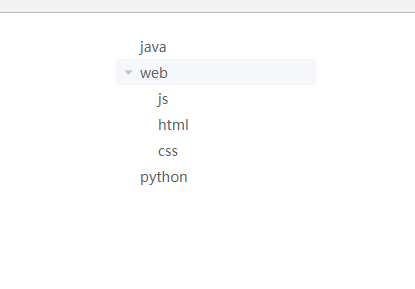在模板中使用el-tree标签 给data属性绑定树形结构数据即可
<el-tree :data="treeData"></el-tree>
接着在data中编写数据
treeData: [ { label: "java", children: [] }, { label: "web", children: [ { label: "js", children: [] }, { label: "html", children: [] }, { label: "css", children: [] } ] }, { label: "python", children: [] } ]
保存,即可看到效果

当然,elementui的树形组件默认是以label字段作为名称显示的,如果没有label字段,比如这个的名称是name,那么树形组件就不会显示文字了
treeData: [ { name: "java", children: [] }, { name: "web", children: [ { name: "js", children: [] }, { name: "html", children: [] }, { name: "css", children: [] } ] }, { name: "python", children: [] } ],
为了能够显示,我们要设置一个字段映射
在data中定义一个对象,比如
customProps:{ label:'name', children:'children' }
然后绑定到树形组件的props属性里即可
<el-tree :props="customProps" :data="treeData"></el-tree>
全部代码
<template> <div id="app"> <div class="box"> <el-tree :props="customProps" :data="treeData"></el-tree> </div> </div></template><script>export default { name: "App", data() { return { treeData: [ { name: "java", children: [] }, { name: "web", children: [ { name: "js", children: [] }, { name: "html", children: [] }, { name: "css", children: [] } ] }, { name: "python", children: [] } ], customProps:{ label:'name', children:'children' } }; }};</script><style>.box { width: 200px; margin: 20px auto;}</style>






























还没有评论,来说两句吧...